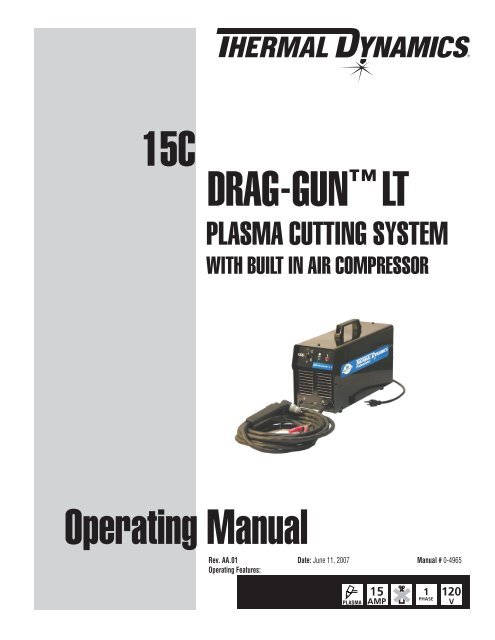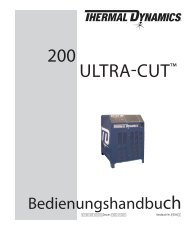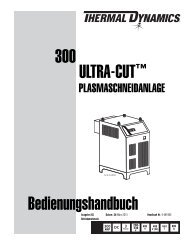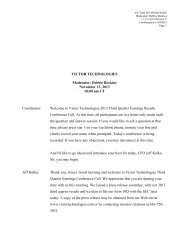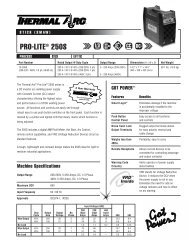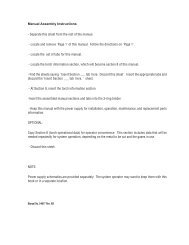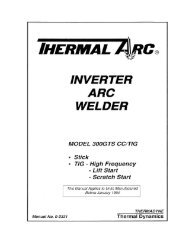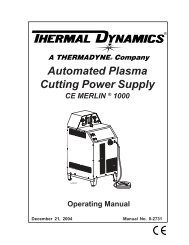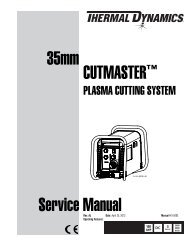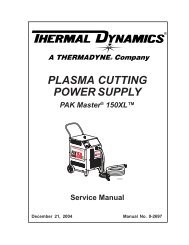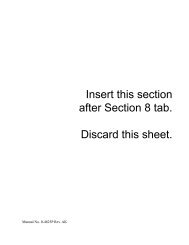Thermal Dynamics 15C Drag-Gun LT Operating Manual_(4965)
Thermal Dynamics 15C Drag-Gun LT Operating Manual_(4965)
Thermal Dynamics 15C Drag-Gun LT Operating Manual_(4965)
You also want an ePaper? Increase the reach of your titles
YUMPU automatically turns print PDFs into web optimized ePapers that Google loves.
<strong>15C</strong><br />
<strong>Operating</strong> <strong>Manual</strong><br />
DRAG-GUN<br />
PLASMA CUTTING SYSTEM<br />
WITH BUI<strong>LT</strong> IN AIR COMPRESSOR<br />
<strong>LT</strong><br />
Rev. AA.01 Date: June 11, 2007 <strong>Manual</strong> # 0-<strong>4965</strong><br />
<strong>Operating</strong> Features:<br />
PLASMA
WE APPRECIATE YOUR BUSINESS!<br />
Congratulations on your new <strong>Thermal</strong> <strong>Dynamics</strong> product. We are<br />
proud to have you as our customer and will strive to provide you<br />
with the best service and reliability in the industry. This product is<br />
backed by our extensive warranty and world-wide service network.<br />
To locate your nearest distributor or service agency call 1-800-426-<br />
1888, or visit us on the web at www.thermadyne.com.<br />
This <strong>Operating</strong> <strong>Manual</strong> has been designed to instruct you on the<br />
correct use and operation of your <strong>Thermal</strong> <strong>Dynamics</strong> product. Your<br />
satisfaction with this product and its safe operation is our ultimate<br />
concern. Therefore please take the time to read the entire manual,<br />
especially the Safety Precautions. They will help you to avoid potential<br />
hazards that may exist when working with this product.<br />
YOU ARE IN GOOD COMPANY!<br />
The Brand of Choice for Contractors and Fabricators Worldwide.<br />
<strong>Thermal</strong> <strong>Dynamics</strong> is a Global Brand of manual and automation<br />
Plasma Cutting Products for Thermadyne Industries Inc.<br />
We distinguish ourselves from our competition through marketleading,<br />
dependable products that have stood the test of time.<br />
We pride ourselves on technical innovation, competitive prices,<br />
excellent delivery, superior customer service and technical support,<br />
together with excellence in sales and marketing expertise.<br />
Above all, we are committed to developing technologically advanced<br />
products to achieve a safer working environment within<br />
the welding industry.
! WARNING<br />
Read and understand this entire <strong>Manual</strong> and your employer’s safety practices before<br />
installing, operating, or servicing the equipment.<br />
While the information contained in this <strong>Manual</strong> represents the Manufacturer's best judgement,<br />
the Manufacturer assumes no liability for its use.<br />
Plasma Cutting Power Supply, <strong>15C</strong> <strong>Drag</strong>-<strong>Gun</strong> <strong>LT</strong><br />
PCH 10 Torch<br />
<strong>Operating</strong> <strong>Manual</strong> No. 0-<strong>4965</strong><br />
Published by:<br />
Thermadyne Corporation<br />
82 Benning Street<br />
West Lebanon, New Hampshire, USA 03784<br />
(603) 298-5711<br />
www.thermadyne.com<br />
© Copyright 2007 by<br />
Thermadyne Corporation<br />
All rights reserved.<br />
Reproduction of this work, in whole or in part, without written permission<br />
of the publisher is prohibited.<br />
The publisher does not assume and hereby disclaims any liability to any<br />
party for any loss or damage caused by any error or omission in this<br />
<strong>Manual</strong>, whether such error results from negligence, accident, or any<br />
other cause.<br />
Printed in the United States of America<br />
Publication Date: June 11, 2007<br />
Record the following information for Warranty purposes:<br />
Where Purchased: ___________________________________<br />
Purchase Date:______________________________________<br />
Power Supply Serial #:_______________________________<br />
Torch Serial #:_____________________________________<br />
i
Intentionally blank
TABLE OF CONTENTS<br />
SECTION 1:GENERAL INFORMATION ...................................................................................1-1<br />
1.01 Notes, Cautions and Warnings ...................................................................1-1<br />
1.02 Important Safety Precautions .....................................................................1-1<br />
1.03 Publications.................................................................................................1-3<br />
1.04 Note, Attention et Avertissement ................................................................1-3<br />
1.05 Precautions De Securite Importantes .........................................................1-4<br />
1.06 Documents De Reference ...........................................................................1-5<br />
1.07 Statement of Warranty ................................................................................1-7<br />
SECTION 2:INTRODUCTION .................................................................................................2-1<br />
2.01 How To Use This <strong>Manual</strong> ............................................................................2-1<br />
2.02 Equipment Identification .............................................................................2-1<br />
2.03 Receipt Of Equipment .................................................................................2-1<br />
2.04 Introduction .................................................................................................2-1<br />
2.05 General Specification ..................................................................................2-2<br />
2.06 Features ......................................................................................................2-2<br />
2.07 Torch Specifications ....................................................................................2-3<br />
2.08 System Contents ........................................................................................2-3<br />
2.09 Transporting Methods .................................................................................2-3<br />
SECTION 3:INSTALLATION .....................................................................................................3-1<br />
3.01 Site Selection ..............................................................................................3-1<br />
3.02 Electrical Input Connections .......................................................................3-1<br />
3.03 Torch ...........................................................................................................3-1<br />
SECTION 4: OPERATION ........................................................................................................4-1<br />
4.01 Front Control Panel .....................................................................................4-1<br />
4.02 Preparations For <strong>Operating</strong> ........................................................................4-1<br />
SECTION 5:SERVICE ..............................................................................................................5-1<br />
5.01 General Maintenance .................................................................................5-1<br />
5.02 Basic Troubleshooting Guide ......................................................................5-2<br />
Appendix 1: <strong>Operating</strong> Sequence, Block Diagram .................................................................. A-1<br />
Appendix 2: Torch Connection ................................................................................................ A-2<br />
Appendix 3: System Schematic 120V .................................................................................... A-3<br />
GLOBAL CUSTOMER SERVICE CONTACT INFORMATION ......................... Inside Rear Cover
TABLE OF CONTENTS<br />
This Page Intentionally Blank
SECTION 1:<br />
GENERAL INFORMATION<br />
1.01 Notes, Cautions and Warnings<br />
Throughout this manual, notes, cautions, and<br />
warnings are used to highlight important information.<br />
These highlights are categorized as follows:<br />
NOTE<br />
An operation, procedure, or background information<br />
which requires additional emphasis or is<br />
helpful in efficient operation of the system.<br />
CAUTION<br />
A procedure which, if not properly followed, may<br />
cause damage to the equipment.<br />
! WARNING<br />
A procedure which, if not properly followed,<br />
may cause injury to the operator or others in<br />
the operating area.<br />
1.02 Important Safety Precautions<br />
! WARNING<br />
OPERATION AND MAINTENANCE OF<br />
PLASMA ARC EQUIPMENT CAN BE DAN-<br />
GEROUS AND HAZARDOUS TO YOUR<br />
HEA<strong>LT</strong>H.<br />
Plasma arc cutting produces intense electric and<br />
magnetic emissions that may interfere with the<br />
proper function of cardiac pacemakers, hearing<br />
aids, or other electronic health equipment. Persons<br />
who work near plasma arc cutting applications<br />
should consult their medical health professional<br />
and the manufacturer of the health equipment to<br />
determine whether a hazard exists.<br />
To prevent possible injury, read, understand<br />
and follow all warnings, safety precautions<br />
and instructions before using the equipment.<br />
Call 1-603-298-5711 or your local distributor<br />
if you have any questions.<br />
<strong>Drag</strong>-gun lt<br />
GASES AND FUMES<br />
Gases and fumes produced during the plasma cutting<br />
process can be dangerous and hazardous to<br />
your health.<br />
• Keep all fumes and gases from the breathing<br />
area. Keep your head out of the welding<br />
fume plume.<br />
• Use an air-supplied respirator if ventilation<br />
is not adequate to remove all fumes and<br />
gases.<br />
• The kinds of fumes and gases from the plasma<br />
arc depend on the kind of metal being<br />
used, coatings on the metal, and the different<br />
processes. You must be very careful when<br />
cutting or welding any metals which may<br />
contain one or more of the following:<br />
Antimony Chromium Mercury<br />
Arsenic Cobalt Nickel<br />
Barium Copper Selenium<br />
Beryllium Lead Silver<br />
Cadmium Manganese Vanadium<br />
• Always read the Material Safety Data Sheets<br />
(MSDS) that should be supplied with the<br />
material you are using. These MSDSs will<br />
give you the information regarding the kind<br />
and amount of fumes and gases that may be<br />
dangerous to your health.<br />
• For information on how to test for fumes and<br />
gases in your workplace, refer to item 1 in<br />
Subsection 1.03, Publications in this manual.<br />
• Use special equipment, such as water or<br />
down draft cutting tables, to capture fumes<br />
and gases.<br />
• Do not use the plasma torch in an area where<br />
combustible or explosive gases or materials<br />
are located.<br />
• Phosgene, a toxic gas, is generated from the<br />
vapors of chlorinated solvents and cleansers.<br />
Remove all sources of these vapors.<br />
• This product, when used for welding or cutting,<br />
produces fumes or gases which contain<br />
chemicals known to the State of California<br />
to cause birth defects and, in some cases,<br />
cancer. (California Health & Safety Code<br />
Sec. 25249.5 et seq.)<br />
<strong>Manual</strong> 0-<strong>4965</strong> 1-1 GENERAL INFORMATION
<strong>Drag</strong>-gun lt<br />
ELECTRIC SHOCK<br />
Electric Shock can injure or kill. The plasma arc<br />
process uses and produces high voltage electrical<br />
energy. This electric energy can cause severe or<br />
fatal shock to the operator or others in the workplace.<br />
• Never touch any parts that are electrically<br />
“live” or “hot.”<br />
• Wear dry gloves and clothing. Insulate yourself<br />
from the work piece or other parts of the<br />
welding circuit.<br />
• Repair or replace all worn or damaged parts.<br />
• Extra care must be taken when the workplace<br />
is moist or damp.<br />
• Install and maintain equipment according<br />
to NEC code, refer to item 9 in Subsection<br />
1.03, Publications.<br />
• Disconnect power source before performing<br />
any service or repairs.<br />
• Read and follow all the instructions in the<br />
<strong>Operating</strong> <strong>Manual</strong>.<br />
FIRE AND EXPLOSION<br />
Fire and explosion can be caused by hot slag,<br />
sparks, or the plasma arc.<br />
• Be sure there is no combustible or flammable<br />
material in the workplace. Any material<br />
that cannot be removed must be protected.<br />
• Ventilate all flammable or explosive vapors<br />
from the workplace.<br />
• Do not cut or weld on containers that may<br />
have held combustibles.<br />
• Provide a fire watch when working in an<br />
area where fire hazards may exist.<br />
• Hydrogen gas may be formed and trapped<br />
under aluminum work pieces when they are<br />
cut underwater or while using a water table.<br />
DO NOT cut aluminum alloys underwater<br />
or on a water table unless the hydrogen gas<br />
can be eliminated or dissipated. Trapped<br />
hydrogen gas that is ignited will cause an<br />
explosion.<br />
NOISE<br />
Noise can cause permanent hearing loss. Plasma<br />
arc processes can cause noise levels to exceed<br />
safe limits. You must protect your ears from loud<br />
noise to prevent permanent loss of hearing.<br />
• To protect your hearing from loud noise,<br />
wear protective ear plugs and/or ear muffs.<br />
Protect others in the workplace.<br />
• Noise levels should be measured to be sure<br />
the decibels (sound) do not exceed safe levels.<br />
• For information on how to test for noise, see<br />
item 1 in Subsection 1.03, Publications, in<br />
this manual.<br />
PLASMA ARC RAYS<br />
Plasma Arc Rays can injure your eyes and burn<br />
your skin. The plasma arc process produces very<br />
bright ultra violet and infra red light. These arc<br />
rays will damage your eyes and burn your skin if<br />
you are not properly protected.<br />
• To protect your eyes, always wear a welding<br />
helmet or shield. Also always wear safety<br />
glasses with side shields, goggles or other<br />
protective eye wear.<br />
• Wear welding gloves and suitable clothing<br />
to protect your skin from the arc rays and<br />
sparks.<br />
• Keep helmet and safety glasses in good<br />
condition. Replace lenses when cracked,<br />
chipped or dirty.<br />
• Protect others in the work area from the<br />
arc rays. Use protective booths, screens or<br />
shields.<br />
• Use the shade of lens as suggested in the following<br />
per ANSI/ASC Z49.1:<br />
Minimum Protective Suggested<br />
Arc Current Shade No. Shade No.<br />
Less Than 300* 8 9<br />
300 - 400* 9 12<br />
400 - 800* 10 14<br />
* These values apply where the actual arc is<br />
clearly seen. Experience has shown that lighter<br />
filters may be used when the arc is hidden by the<br />
work piece.<br />
General Information 1-2 <strong>Manual</strong> 0-<strong>4965</strong>
1.03 Publications<br />
Refer to the following standards or their latest<br />
revisions for more information:<br />
1. OSHA, SAFETY AND HEA<strong>LT</strong>H STANDARDS, 29CFR<br />
1910, obtainable from the Superintendent of Documents,<br />
U.S. Government Printing Office, Washington,<br />
D.C. 20402<br />
2. ANSI Standard Z49.1, SAFETY IN WELDING AND<br />
CUTTING, obtainable from the American Welding<br />
Society, 550 N.W. LeJeune Rd, Miami, FL 33126<br />
3. NIOSH, SAFETY AND HEA<strong>LT</strong>H IN ARC WELDING<br />
AND GAS WELDING AND CUTTING, obtainable<br />
from the Superintendent of Documents, U.S. Government<br />
Printing Office, Washington, D.C. 20402<br />
4. ANSI Standard Z87.1, SAFE PRACTICES FOR OC-<br />
CUPATION AND EDUCATIONAL EYE AND FACE<br />
PROTECTION, obtainable from American National<br />
Standards Institute, 1430 Broadway, New York, NY<br />
10018<br />
5. ANSI Standard Z41.1, STANDARD FOR MEN’S SAFE-<br />
TY-TOE FOOTWEAR, obtainable from the American<br />
National Standards Institute, 1430 Broadway, New<br />
York, NY 10018<br />
6. ANSI Standard Z49.2, FIRE PREVENTION IN THE USE<br />
OF CUTTING AND WELDING PROCESSES, obtainable<br />
from American National Standards Institute, 1430<br />
Broadway, New York, NY 10018<br />
7. AWS Standard A6.0, WELDING AND CUTTING CON-<br />
TAINERS WHICH HAVE HELD COMBUSTIBLES,<br />
obtainable from American Welding Society, 550 N.W.<br />
LeJeune Rd, Miami, FL 33126<br />
8. NFPA Standard 51, OXYGEN-FUEL GAS SYSTEMS<br />
FOR WELDING, CUTTING AND ALLIED PRO-<br />
CESSES, obtainable from the National Fire Protection<br />
Association, Batterymarch Park, Quincy, MA 02269<br />
9. NFPA Standard 70, NATIONAL ELECTRICAL CODE,<br />
obtainable from the National Fire Protection Association,<br />
Batterymarch Park, Quincy, MA 02269<br />
10. NFPAStandard 51B, CUTTING AND WELDING PRO-<br />
CESSES, obtainable from the National Fire Protection<br />
Association, Batterymarch Park, Quincy, MA 02269<br />
11. CGA Pamphlet P-1, SAFE HANDLING OF COM-<br />
PRESSED GASES IN CYLINDERS, obtainable from<br />
the Compressed Gas Association, 1235 Jefferson Davis<br />
Highway, Suite 501, Arlington, VA 22202<br />
12. CSA Standard W117.2, CODE FOR SAFETY IN WELD-<br />
ING AND CUTTING, obtainable from the Canadian<br />
Standards Association, Standards Sales, 178 Rexdale<br />
Boulevard, Rexdale, Ontario, Canada M9W 1R3<br />
13. NWSA booklet, WELDING SAFETY BIBLIOGRAPHY<br />
obtainable from the National Welding Supply Association,<br />
1900 Arch Street, Philadelphia, PA 19103<br />
<strong>Drag</strong>-gun lt<br />
14. American Welding Society Standard AWSF4.1, REC-<br />
OMMENDED SAFE PRACTICES FOR THE PREPARA-<br />
TION FOR WELDING AND CUTTING OF CONTAIN-<br />
ERS AND PIPING THAT HAVE HELD HAZARDOUS<br />
SUBSTANCES, obtainable from the American Welding<br />
Society, 550 N.W. LeJeune Rd, Miami, FL 33126<br />
15. ANSI Standard Z88.2, PRACTICE FOR RESPIRATORY<br />
PROTECTION, obtainable from American National<br />
Standards Institute, 1430 Broadway, New York, NY<br />
10018<br />
1.04 Note, Attention et<br />
Avertissement<br />
Dans ce manuel, les mots “note,” “attention,” et<br />
“avertissement” sont utilisés pour mettre en relief<br />
des informations à caractère important. Ces mises<br />
en relief sont classifiées comme suit :<br />
NOTE<br />
Toute opération, procédure ou renseignement<br />
général sur lequel il importe d’insister davantage<br />
ou qui contribue à l’efficacité de fonctionnement<br />
du système.<br />
ATTENTION<br />
Toute procédure pouvant résulter<br />
l’endommagement du matériel en cas de nonrespect<br />
de la procédure en question.<br />
! AVERTISSEMENT<br />
Toute procédure pouvant provoquer des blessures<br />
de l’opérateur ou des autres personnes<br />
se trouvant dans la zone de travail en cas de<br />
non-respect de la procédure en question.<br />
<strong>Manual</strong> 0-<strong>4965</strong> 1-3 GENERAL INFORMATION
<strong>Drag</strong>-gun lt<br />
1.05 Precautions De Securite<br />
Importantes<br />
! AVERTISSEMENT<br />
L’OPÉRATION ET LA MAINTENANCE DU<br />
MATÉRIEL DE SOUDAGE À L’ARC AU JET<br />
DE PLASMA PEUVENT PRÉSENTER DES<br />
RISQUES ET DES DANGERS DE SANTÉ.<br />
Coupant à l’arc au jet de plasma produit de<br />
l’énergie électrique haute tension et des émissions<br />
magnétique qui peuvent interférer la fonction<br />
propre d’un “pacemaker” cardiaque, les appareils<br />
auditif, ou autre matériel de santé electronique.<br />
Ceux qui travail près d’une application à l’arc<br />
au jet de plasma devrait consulter leur membre<br />
professionel de médication et le manufacturier de<br />
matériel de santé pour déterminer s’il existe des<br />
risques de santé.<br />
Il faut communiquer aux opérateurs et au<br />
personnel TOUS les dangers possibles.<br />
Afin d’éviter les blessures possibles, lisez,<br />
comprenez et suivez tous les avertissements,<br />
toutes les précautions de sécurité et toutes les<br />
consignes avant d’utiliser le matériel. Composez<br />
le + 603-298-5711 ou votre distributeur<br />
local si vous avez des questions.<br />
FUMÉE et GAZ<br />
La fumée et les gaz produits par le procédé de jet<br />
de plasma peuvent présenter des risques et des<br />
dangers de santé.<br />
• Eloignez toute fumée et gaz de votre zone de respiration.<br />
Gardez votre tête hors de la plume de fumée<br />
provenant du chalumeau.<br />
• Utilisez un appareil respiratoire à alimentation en<br />
air si l’aération fournie ne permet pas d’éliminer la<br />
fumée et les gaz.<br />
• Les sortes de gaz et de fumée provenant de l’arc de<br />
plasma dépendent du genre de métal utilisé, des<br />
revêtements se trouvant sur le métal et des différents<br />
procédés. Vous devez prendre soin lorsque vous<br />
coupez ou soudez tout métal pouvant contenir un ou<br />
plusieurs des éléments suivants:<br />
antimoine cadmium mercure<br />
argent chrome nickel<br />
arsenic cobalt plomb<br />
baryum cuivre sélénium<br />
béryllium manganèse vanadium<br />
• Lisez toujours les fiches de données sur la sécurité<br />
des matières (sigle américain “MSDS”); celles-ci<br />
devraient être fournies avec le matériel que vous<br />
utilisez. Les MSDS contiennent des renseignements<br />
quant à la quantité et la nature de la fumée et des gaz<br />
pouvant poser des dangers de santé.<br />
• Pour des informations sur la manière de tester la<br />
fumée et les gaz de votre lieu de travail, consultez<br />
l’article 1 et les documents cités à la page 5.<br />
• Utilisez un équipement spécial tel que des tables de<br />
coupe à débit d’eau ou à courant descendant pour<br />
capter la fumée et les gaz.<br />
• N’utilisez pas le chalumeau au jet de plasma dans<br />
une zone où se trouvent des matières ou des gaz<br />
combustibles ou explosifs.<br />
• Le phosgène, un gaz toxique, est généré par la fumée<br />
provenant des solvants et des produits de nettoyage<br />
chlorés. Eliminez toute source de telle fumée.<br />
• Ce produit, dans le procéder de soudage et de coupe,<br />
produit de la fumée ou des gaz pouvant contenir des<br />
éléments reconnu dans L’état de la Californie, qui<br />
peuvent causer des défauts de naissance et le cancer.<br />
(La sécurité de santé en Californie et la code sécurité<br />
Sec. 25249.5 et seq.)<br />
CHOC ELECTRIQUE<br />
Les chocs électriques peuvent blesser ou même<br />
tuer. Le procédé au jet de plasma requiert et<br />
produit de l’énergie électrique haute tension.<br />
Cette énergie électrique peut produire des chocs<br />
graves, voire mortels, pour l’opérateur et les autres<br />
personnes sur le lieu de travail.<br />
• Ne touchez jamais une pièce “sous tension” ou<br />
“vive”; portez des gants et des vêtements secs. Isolezvous<br />
de la pièce de travail ou des autres parties du<br />
circuit de soudage.<br />
• Réparez ou remplacez toute pièce usée ou endommagée.<br />
• Prenez des soins particuliers lorsque la zone de travail<br />
est humide ou moite.<br />
• Montez et maintenez le matériel conformément au<br />
Code électrique national des Etats-Unis. (Voir la page<br />
5, article 9.)<br />
• Débranchez l’alimentation électrique avant tout<br />
travail d’entretien ou de réparation.<br />
• Lisez et respectez toutes les consignes du Manuel de<br />
consignes.<br />
General Information 1-4 <strong>Manual</strong> 0-<strong>4965</strong>
INCENDIE ET EXPLOSION<br />
Les incendies et les explosions peuvent résulter<br />
des scories chaudes, des étincelles ou de l’arc de<br />
plasma. Le procédé à l’arc de plasma produit du<br />
métal, des étincelles, des scories chaudes pouvant<br />
mettre le feu aux matières combustibles ou provoquer<br />
l’explosion de fumées inflammables.<br />
• Soyez certain qu’aucune matière combustible ou inflammable<br />
ne se trouve sur le lieu de travail. Protégez<br />
toute telle matière qu’il est impossible de retirer de<br />
la zone de travail.<br />
• Procurez une bonne aération de toutes les fumées<br />
inflammables ou explosives.<br />
• Ne coupez pas et ne soudez pas les conteneurs ayant<br />
pu renfermer des matières combustibles.<br />
• Prévoyez une veille d’incendie lors de tout travail<br />
dans une zone présentant des dangers d’incendie.<br />
• Le gas hydrogène peut se former ou s’accumuler<br />
sous les pièces de travail en aluminium lorsqu’elles<br />
sont coupées sous l’eau ou sur une table d’eau. NE<br />
PAS couper les alliages en aluminium sous l’eau ou<br />
sur une table d’eau à moins que le gas hydrogène<br />
peut s’échapper ou se dissiper. Le gas hydrogène<br />
accumulé explosera si enflammé.<br />
RAYONS D’ARC DE PLASMA<br />
Les rayons provenant de l’arc de plasma peuvent<br />
blesser vos yeux et brûler votre peau. Le procédé<br />
à l’arc de plasma produit une lumière infra-rouge<br />
et des rayons ultra-violets très forts. Ces rayons<br />
d’arc nuiront à vos yeux et brûleront votre peau si<br />
vous ne vous protégez pas correctement.<br />
• Pour protéger vos yeux, portez toujours un casque<br />
ou un écran de soudeur. Portez toujours des lunettes<br />
de sécurité munies de parois latérales ou des lunettes<br />
de protection ou une autre sorte de protection oculaire.<br />
• Portez des gants de soudeur et un vêtement protecteur<br />
approprié pour protéger votre peau contre<br />
les étincelles et les rayons de l’arc.<br />
• Maintenez votre casque et vos lunettes de protection<br />
en bon état. Remplacez toute lentille sale ou comportant<br />
fissure ou rognure.<br />
• Protégez les autres personnes se trouvant sur la zone<br />
de travail contre les rayons de l’arc en fournissant des<br />
cabines ou des écrans de protection.<br />
<strong>Drag</strong>-gun lt<br />
• Utilisez la nuance de lentille qui est suggèrée dans<br />
le recommendation qui suivent ANSI/ASC Z49.1:<br />
Nuance Minimum Nuance Suggerée<br />
Courant Arc Protective Numéro Numéro<br />
Moins de 300* 8 9<br />
300 - 400* 9 12<br />
400 - 800* 10 14<br />
* Ces valeurs s’appliquent ou l’arc actuel est<br />
observé clairement. L’experience a démontrer que<br />
les filtres moins foncés peuvent être utilisés quand<br />
l’arc est caché par moiceau de travail.<br />
BRUIT<br />
Le bruit peut provoquer une perte permanente de<br />
l’ouïe. Les procédés de soudage à l’arc de plasma<br />
peuvent provoquer des niveaux sonores supérieurs<br />
aux limites normalement acceptables. Vous dú4ez<br />
vous protéger les oreilles contre les bruits forts<br />
afin d’éviter une perte permanente de l’ouïe.<br />
• Pour protéger votre ouïe contre les bruits forts, portez<br />
des tampons protecteurs et/ou des protections auriculaires.<br />
Protégez également les autres personnes<br />
se trouvant sur le lieu de travail.<br />
• Il faut mesurer les niveaux sonores afin d’assurer que<br />
les décibels (le bruit) ne dépassent pas les niveaux<br />
sûrs.<br />
• Pour des renseignements sur la manière de tester le<br />
bruit, consultez l’article 1, page 5.<br />
1.06 Documents De Reference<br />
Consultez les normes suivantes ou les révisions<br />
les plus récentes ayant été faites à celles-ci pour<br />
de plus amples renseignements :<br />
1. OSHA, NORMES DE SÉCURITÉ DU TRAVAIL ET<br />
DE PROTECTION DE LA SANTÉ, 29CFR 1910, disponible<br />
auprès du Superintendent of Documents,<br />
U.S. Government Printing Office, Washington, D.C.<br />
20402<br />
2. Norme ANSI Z49.1, LA SÉCURITÉ DES OPÉRA-<br />
TIONS DE COUPE ET DE SOUDAGE, disponible<br />
auprès de la Société Américaine de Soudage (American<br />
Welding Society), 550 N.W. LeJeune Rd., Miami,<br />
FL 33126<br />
3. NIOSH, LA SÉCURITÉ ET LA SANTÉ LORS DES<br />
OPÉRATIONS DE COUPE ET DE SOUDAGE À<br />
L’ARC ET AU GAZ, disponible auprès du Superintendent<br />
of Documents, U.S. Government Printing<br />
Office, Washington, D.C. 20402<br />
<strong>Manual</strong> 0-<strong>4965</strong> 1-5 GENERAL INFORMATION
<strong>Drag</strong>-gun lt<br />
4. Norme ANSI Z87.1, PRATIQUES SURES POUR<br />
LA PROTECTION DES YEUX ET DU VISAGE AU<br />
TRAVAIL ET DANS LES ECOLES, disponible de<br />
l’Institut Américain des Normes Nationales (American<br />
National Standards Institute), 1430 Broadway,<br />
New York, NY 10018<br />
5. Norme ANSI Z41.1, NORMES POUR LES<br />
CHAUSSURES PROTECTRICES, disponible auprès<br />
de l’American National Standards Institute, 1430<br />
Broadway, New York, NY 10018<br />
6. NormeANSI Z49.2, PRÉVENTION DES INCENDIES<br />
LORS DE L’EMPLOI DE PROCÉDÉS DE COUPE ET<br />
DE SOUDAGE, disponible auprès de l’American<br />
National Standards Institute, 1430 Broadway, New<br />
York, NY 10018<br />
7. Norme A6.0 de l’Association Américaine du Soudage<br />
(AWS), LE SOUDAGE ET LA COUPE DE CON-<br />
TENEURS AYANT RENFERMÉ DES PRODUITS<br />
COMBUSTIBLES, disponible auprès de la American<br />
Welding Society, 550 N.W. LeJeune Rd., Miami, FL<br />
33126<br />
8. Norme 51 de l’AssociationAméricaine pour la Protection<br />
contre les Incendies (NFPA), LES SYSTEMES À<br />
GAZ AVEC ALIMENTATION EN OXYGENE POUR<br />
LE SOUDAGE, LA COUPE ET LES PROCÉDÉS<br />
ASSOCIÉS, disponible auprès de la National Fire<br />
Protection Association, Batterymarch Park, Quincy,<br />
MA 02269<br />
9. Norme 70 de la NFPA, CODE ELECTRIQUE NA-<br />
TIONAL, disponible auprès de la National Fire<br />
Protection Association, Batterymarch Park, Quincy,<br />
MA 02269<br />
10. Norme 51B de la NFPA, LES PROCÉDÉS DE COUPE<br />
ET DE SOUDAGE, disponible auprès de la National<br />
Fire Protection Association, Batterymarch Park,<br />
Quincy, MA 02269<br />
11. Brochure GCA P-1, LA MANIPULATION SANS<br />
RISQUE DES GAZ COMPRIMÉS EN CYLINDRES,<br />
disponible auprès de l’Association des Gaz Comprimés<br />
(Compressed Gas Association), 1235 Jefferson<br />
Davis Highway, Suite 501, Arlington, VA 22202<br />
12. Norme CSA W117.2, CODE DE SÉCURITÉ POUR<br />
LE SOUDAGE ET LA COUPE, disponible auprès de<br />
l’Association des Normes Canadiennes, Standards<br />
Sales, 178 Rexdale Boulevard, Rexdale, Ontario,<br />
Canada, M9W 1R3<br />
General Information 1-6 <strong>Manual</strong> 0-<strong>4965</strong>
1.07 Statement of Warranty<br />
<strong>Drag</strong>-gun lt<br />
LIMITED WARRANTY: Subject to the terms and conditions established below, Thermadyne ® Corporation warrants to the original<br />
retail purchaser that new <strong>Thermal</strong> <strong>Dynamics</strong> Series plasma cutting systems sold after the effective date of this warranty are free of<br />
defects in material and workmanship. Should any failure to conform to this warranty appear within the applicable period stated below,<br />
Thermadyne Corporation shall, upon notification thereof and substantiation that the product has been stored operated and maintained<br />
in accordance with Thermadynes’ specifications, instructions, recommendations and recognized industry practice, correct such defects<br />
by suitable repair or replacement.<br />
This warranty is exclusive and in lieu of any warranty of merchantability or fitness for a particular purpose.<br />
Thermadyne will repair or replace, at its discretion, any warranted parts or components that fail due to defects in material or workmanship<br />
within the time periods set out below. Thermadyne Corporation must be notified within 30 days of any failure, at which time Thermadyne<br />
Corporation will provide instructions on the warranty procedures to be implemented.<br />
Thermadyne Corporation will honor warranty claims submitted within the warranty periods listed below. All warranty periods begin<br />
on the date of sale of the product to the original retail customer or 1 year after sale to an authorized Thermadyne Distributor.<br />
LIMITED WARRANTY PERIOD<br />
This warranty does not apply to:<br />
Product Power Supply Components<br />
(Parts and Labor)<br />
Torch and Leads<br />
(Parts and Labor)<br />
<strong>Drag</strong>-<strong>Gun</strong> <strong>LT</strong> 1 Year 180 days<br />
1. Consumable Parts, such as tips, electrodes, shield cups, o - rings, starter cartridges, gas distributors, fuses, filters.<br />
2. Equipment that has been modified by an unauthorized party, improperly installed, improperly operated or misused<br />
based upon industry standards.<br />
In the event of a claim under this warranty, the remedies shall be, at the discretion of Thermadyne Corporation:<br />
1. Repair of the defective product.<br />
2. Replacement of the defective product.<br />
3. Reimbursement of reasonable costs of repair when authorized in advance by Thermadyne.<br />
4. Payment of credit up to the purchase price less reasonable depreciation based on actual use.<br />
These remedies may be authorized by Thermadyne and are FOB West Lebanon, NH or an authorized Thermadyne service station.<br />
Product returned for service is at the owner’s expense and no reimbursement of travel or transportation is authorized.<br />
LIMITATION OF LIABILITY: Thermadyne Corporation shall not under any circumstances be liable for special or consequential<br />
damages such as, but not limited to, damage or loss of purchased or replacement goods or claims of customer of distributors (hereinafter<br />
“Purchaser”) for service interruption. The remedies of the Purchaser set forth herein are exclusive and the liability of Thermadyne with<br />
respect to any contract, or anything done in connection therewith such as the performance or breach thereof, or from the manufacture,<br />
sale, delivery, resale, or use of the goods covered by or furnished by Thermadyne whether arising out of contract, negligence, strict<br />
tort, or under any warranty, or otherwise, shall not, except as expressly provided herein, exceed the price of the goods upon which<br />
liability is based.<br />
This warranty becomes invalid if replacement parts or accessories are used which may impair the safety or performance of any<br />
Thermadyne product.<br />
This warranty is invalid if the Thermadyne product is sold by non - authorized persons.<br />
Effective May 23, 2007<br />
<strong>Manual</strong> 0-<strong>4965</strong> 1-7 GENERAL INFORMATION
<strong>Drag</strong>-gun lt<br />
This Page Intentionally Blank<br />
General Information 1-8 <strong>Manual</strong> 0-<strong>4965</strong>
SECTION 2:<br />
INTRODUCTION<br />
2.01 How To Use This <strong>Manual</strong><br />
This Owner’s <strong>Manual</strong> applies to just specification<br />
or part numbers listed on page i.<br />
To ensure safe operation, read the entire manual,<br />
including the chapter on safety instructions and<br />
warnings.<br />
Throughout this manual, the words WARNING,<br />
CAUTION, and NOTE may appear. Pay particular<br />
attention to the information provided under<br />
these headings. These special annotations are<br />
easily recognized as follows:<br />
! WARNING<br />
A WARNING gives information regarding<br />
possible personal injury.<br />
CAUTION<br />
A CAUTION refers to possible equipment<br />
damage.<br />
NOTE<br />
A NOTE offers helpful information concerning<br />
certain operating procedures.<br />
Additional copies of this manual may be purchased<br />
by contacting <strong>Thermal</strong> <strong>Dynamics</strong> at the<br />
address and phone number in your area listed in<br />
the inside back cover of this manual. Include the<br />
Owner’s <strong>Manual</strong> number and equipment identification<br />
numbers.<br />
Electronic copies of this manual can also be<br />
downloaded at no charge in Acrobat PDF format<br />
by going to the<br />
Thermadyne web site listed below, clicking on<br />
the <strong>Thermal</strong> <strong>Dynamics</strong> brand logo and then on<br />
the Literature link:<br />
http://www.thermadyne.com<br />
<strong>Drag</strong>-gun lt<br />
2.02 Equipment Identification<br />
The unit’s identification number (specification<br />
or part number), model, and serial number<br />
usually appear on a data tag attached to the rear<br />
panel. Equipment which does not have a data tag<br />
such as torch and cable assemblies are identified<br />
only by the specification or part number<br />
printed on loosely attached card or the shipping<br />
container. Record these numbers on the bottom<br />
of page i for future reference.<br />
2.03 Receipt Of Equipment<br />
When you receive the equipment, check it<br />
against the invoice to make sure it is complete<br />
and inspect the equipment for possible damage<br />
due to shipping. If there is any damage, notify<br />
the carrier immediately to file a claim. Furnish<br />
complete information concerning damage claims<br />
or shipping errors to the location in your area<br />
listed in the inside back cover of this manual.<br />
Include all equipment identification numbers as<br />
described above along with a full description of<br />
the parts in error.<br />
2.04 Introduction<br />
Plasma is a gas which has been heated to an<br />
extremely high temperature and ionized so that<br />
it becomes electrically conductive. The plasma<br />
arc cutting process uses this plasma to transfer<br />
an electrical arc to the workpiece. The metal to<br />
be cut is melted by the heat of the arc and then<br />
blown away.<br />
Introduction 2-1 <strong>Manual</strong> 0-<strong>4965</strong>
<strong>Drag</strong>-gun lt<br />
2.05 General Specification<br />
Model Description<br />
<strong>15C</strong> <strong>Drag</strong>-<strong>Gun</strong><br />
<strong>LT</strong><br />
Maximum output 15 Amps<br />
Input Voltage & Phase<br />
120V,<br />
Single Phase<br />
Frequency 60Hz<br />
Input power 2.2 kVA<br />
Current Input fuse<br />
U.S. / Canada 20<br />
Amps<br />
No Load Voltage 330V<br />
Load Voltage 86V<br />
Output Current 15 Amps<br />
Post flow time 12 Seconds<br />
Duty cycle @ 104°F /<br />
40° C Ambient<br />
Genuine Cutting<br />
Capacity<br />
Maximum Cutting<br />
Capacity<br />
Dimension (W * D * H)<br />
30% @ 15A,<br />
86vdc<br />
3/16”<br />
(4.5 mm)<br />
1/4”<br />
(6.5 mm)<br />
6.5”x18”x9.5” (165<br />
mm x 457 mm x<br />
241 mm )<br />
Gross Weight 30 lbs. (11.2 kg )<br />
NOTE:<br />
Refer to Local and National Codes or local authority<br />
having jurisdiction for proper wiring<br />
requirements.<br />
2.06 Features<br />
• COMPACT and LIGHT - Designed for easy<br />
transportation.<br />
• ENERGY EFFICIENCY - Advanced technology<br />
reduces power consumption.<br />
• HIGH SPEED GENUINE CUTTING - The<br />
constricted plasma arc provides high speed<br />
cutting as well as a good quality genuine,<br />
narrow cut.<br />
• LOW COST WITH COMPRESSED AIR<br />
- The <strong>Drag</strong>-<strong>Gun</strong> <strong>LT</strong> operates on its owncompressed<br />
air.<br />
• ALL KINDS OF METALS - Useful for<br />
most metals such as stainless steel, aluminum,<br />
mild steel, copper and their alloys.<br />
• PILOT ARC IGNITION FROM TORCH<br />
- The Pilot Arc ignites the cutting arc.<br />
• POWERFUL CUTTING PERFORMANCE<br />
- Genuine cutting capacity is 3/16” (4.5<br />
mm).<br />
• ABLE TO CUT PAINTED MATERIALS<br />
- Pilot Arc ignition allows the <strong>Drag</strong>-<strong>Gun</strong><br />
<strong>LT</strong> to cut painted materials.<br />
• EXTENDED PARTS LIFE - Consumable<br />
parts life is longer.<br />
Introduction 2-2 <strong>Manual</strong> 0-<strong>4965</strong>
2.07 Torch Specifications<br />
8 in (203 mm)<br />
Torch Configuration<br />
1.1 in (27 mm)<br />
PCH-10 Torch Ratings<br />
2.9 in<br />
(75 mm)<br />
Art # A-07719<br />
Torch Head at 70° to<br />
Torch Handle<br />
Torch Leads Length 20 feet / 6.1 m<br />
Duty Cycle 100% @ 10 Amps<br />
Maximum Current<br />
Type of Cooling<br />
Parts-in-Place:<br />
Gas Requirement:<br />
Plasma Power<br />
Supply Used With:<br />
15 Amps, DC,<br />
Straight Polarity<br />
Ambient air and gas<br />
stream through torch<br />
Built-in Switch<br />
in Torch Head<br />
Single Gas, Internal<br />
Compressed Air Only<br />
<strong>Drag</strong>-<strong>Gun</strong> <strong>LT</strong><br />
2.08 System Contents<br />
<strong>Drag</strong>-gun lt<br />
Description ITEMS Q’ty<br />
Power source Model <strong>Drag</strong>-<strong>Gun</strong> <strong>LT</strong> 1<br />
Torch Set<br />
Accessories &<br />
Consumables<br />
Input Power<br />
Cable U.S.<br />
PCH-10, with 20’<br />
(6.1 m) leads<br />
Work Cable<br />
<strong>Manual</strong><br />
Torch Electrodes<br />
Torch Tips<br />
Introduction 2-3 <strong>Manual</strong> 0-<strong>4965</strong><br />
1<br />
1<br />
1<br />
2<br />
3<br />
16/3 with molded plug 1<br />
2.09 Transporting Methods<br />
Lift unit with handle on top of case. Use handcart<br />
or similar device of adequate capacity for<br />
transporting over long distances.<br />
WARNINGS<br />
ELECTRIC SHOCK can kill. DO NOT<br />
TOUCH live electrical parts. Disconnect input<br />
power from supply before moving the power<br />
source.<br />
FALLING EQUIPMENT can cause serious<br />
personal injury and equipment damage.
<strong>Drag</strong>-gun lt<br />
This Page Intentionally Blank<br />
Introduction 2-4 <strong>Manual</strong> 0-<strong>4965</strong>
SECTION 3:<br />
INSTALLATION<br />
3.01 Site Selection<br />
• Place in a clean and dry area.<br />
• Provide adequate ventilation and fresh air<br />
supply.<br />
• Ideal ambient temperature should not exceed<br />
40°C / 104°F. Temperatures exceeding<br />
that may diminish cutting capacity or<br />
quality.<br />
• The cutting machine must be placed on an<br />
even, firm surface.<br />
3.02 Electrical Input Connections<br />
• Input voltage is 120V ± 10%, 50/60 Hz<br />
single phase.<br />
CAUTION<br />
Check your power source for correct voltage<br />
before plugging in or connecting the unit. The<br />
primary power source, fuse/breaker, and any<br />
extension cords used must conform to local<br />
electrical code and the recommended circuit<br />
protection and wiring requirements as specified<br />
in Section 2.<br />
3.03 Torch<br />
<strong>Drag</strong>-gun lt<br />
• Make sure that the torch cable and torch<br />
switch terminals are connected to front<br />
panel.<br />
• Make sure the Work Cable is secured properly<br />
to front panel.<br />
• Before activating, turn torch away from<br />
yourself and others.<br />
DANGER<br />
Do not cut in humid or wet surroundings.<br />
• Before you maintain or replace torch parts,<br />
wait for the post flow air cycle to stop, then<br />
turn the machine off and disconnect from<br />
input power.<br />
• Always use original manufacturers parts.<br />
The use of aftermarket parts could result in<br />
lower parts life and in unsatisfactory cutting<br />
results. Any warranty claims would be<br />
waived.<br />
• Recycle worn parts according to local requirements.<br />
NOTE<br />
Repairs must be done by skilled and qualified<br />
personnel only.<br />
Installation 3-1 <strong>Manual</strong> 0-<strong>4965</strong>
<strong>Drag</strong>-gun lt<br />
This Page Intentionally<br />
Installation 3-2 <strong>Manual</strong> 0-<strong>4965</strong>
SECTION 4:<br />
OPERATION<br />
4.01 Front Control Panel<br />
"On / Off"<br />
Switch<br />
Air Vents<br />
Work Lead<br />
Connection<br />
INDICATOR LAMP<br />
AC Power<br />
Indicator<br />
Art # A-07724<br />
Overheating<br />
Indicator<br />
Torch Lead<br />
Connection<br />
• Power Indicator - Lights when primary<br />
power switch is turned on.<br />
• TEMPERATURE Indicator - Indicator<br />
is normally OFF. Indicator is ON when<br />
internal temperature exceeds normal limits.<br />
Shut unit OFF; let the unit cool before<br />
continuing operation.<br />
PRIMARY POWER SWITCH, ON / OFF<br />
The power switch is located on the front panel.<br />
Placing the primary power switch to the “ON”<br />
position energizes the power source.<br />
CAUTION<br />
When the power source is overloaded, the switch<br />
turns to the OFF or neutral position automatically.<br />
Return completely to the OFF positioin<br />
before attempting to turn ON again.<br />
<strong>Drag</strong>-gun lt<br />
4.02 Preparations For <strong>Operating</strong><br />
At the start of each operating session:<br />
WARNING<br />
Disconnect primary power at the source<br />
before assembling or disassembling power<br />
supply, torch parts, or torch and leads assemblies.<br />
Torch Parts Selection<br />
Check the torch for proper assembly and appropriate<br />
torch parts. The torch parts must correspond<br />
with the type of operation, and with the amperage<br />
output of this Power Supply (15 amps maximum).<br />
Use only genuine manufacturer’s parts with this<br />
torch.<br />
Torch Head<br />
Assembly<br />
Electrode,<br />
9-6006<br />
Gas Distributor,<br />
9-6007<br />
Tip, 9-6099<br />
Shield Cup,<br />
9-6003<br />
Operation 4-1 <strong>Manual</strong> 0-<strong>4965</strong><br />
A-07723
<strong>Drag</strong>-gun lt<br />
Connect Work Cable<br />
Torch Operation<br />
Make a solid work cable<br />
connection to the workpiece<br />
or cutting table<br />
A-02022<br />
• Wear gloves and protective goggles.<br />
• Do not place bare hand on work piece.<br />
1. For drag cutting, keep the torch in contact<br />
with the work piece.<br />
2. For standoff cutting, hold the torch 1/8<br />
- 3/8 in (3-9 mm) from the work piece as<br />
shown below.<br />
A-00024<br />
Torch<br />
Shield Cup<br />
Standoff<br />
Distance 1/8" - 3/8"<br />
3. With the torch in starting position, press<br />
and hold the Torch Trigger. The pilot arc<br />
will come on and remain on until the cutting<br />
arc starts.<br />
4. Once on, the cutting arc remains on as<br />
long as the Torch Trigger is held down.<br />
5. To shut off the torch simply release the<br />
Torch Trigger. When the trigger is released<br />
a gas post-flow will occur. If the<br />
Torch Trigger is pushed during the postflow,<br />
the pilot arc will restart immediately<br />
and the cutting arc will restart when the<br />
torch is brought within range of the work<br />
piece.<br />
Typical Cutting Speeds<br />
Cutting speeds vary according to torch output,<br />
the type of material being cut, and operator skill.<br />
Speeds shown are typical for this cutting system<br />
using air plasma to cut materials shown.<br />
Material Material<br />
Mild Steel<br />
Inches Per<br />
1/8” 25.0<br />
3/16” 16.0<br />
1/4” slow speeds<br />
Operation 4-2 <strong>Manual</strong> 0-<strong>4965</strong>
5.01 General Maintenance<br />
SECTION 5:<br />
SERVICE<br />
Warning!<br />
Disconnect input power before maintaining.<br />
Visually inspect the torch body<br />
tip, electrode and shield cup<br />
Art # A-07891<br />
Replace all<br />
broken parts<br />
Visual check of<br />
torch tip and electrode<br />
Each Use<br />
Weekly<br />
Visually inspect the<br />
cables and leads.<br />
Replace as needed<br />
3 Months<br />
6 Months<br />
Visually check and<br />
Carefully clean the<br />
interior<br />
Clean<br />
exterior<br />
of power supply<br />
<strong>Drag</strong>-gun lt<br />
Maintain more often<br />
if used under severe<br />
conditions<br />
<strong>Manual</strong> 0-<strong>4965</strong> 5-1 SERVICE
<strong>Drag</strong>-gun lt<br />
5.02 Basic Troubleshooting Guide<br />
WARNING<br />
There are extremely dangerous voltage and power levels present inside this unit. Do not attempt to<br />
diagnose or repair unless you have had training in power electronics measurement and troubleshooting<br />
techniques.<br />
Basic Troubleshooting, Overview<br />
This guide covers basic troubleshooting. It is helpful for solving many of the common problems that<br />
can arise with this system. If major complex subassemblies are faulty, the unit must be returned to an<br />
authorized service center for repair.<br />
Follow all instructions as listed and complete each section in the order presented.<br />
Common Symptoms<br />
Problem - Symptom Possible Cause Recommended Action<br />
Power Switch is on 1. Improper electrical connection.<br />
but the A/C Indicator 2. System was overloaded.<br />
does not light 3. Switch may be faulty<br />
Primary power switch 1. No power or incorrect power to fan.<br />
is on, but the cooling 2. Faulty fan.<br />
fan does not work.<br />
No air flow at torch 1. Internal connection is loose or<br />
when torch switch is disconnected.<br />
activated. 2. Internal air supply / compressor not<br />
working.<br />
3. Control PCB faulty<br />
Torch will not pilot 1. Air pressure too high or too low.<br />
when torch switch is 2. Torch consumables missing.<br />
activated. 3. Worn or faulty torch parts<br />
4. <strong>Thermal</strong> Switch activated<br />
Cut performance is<br />
diminished.<br />
1. Worn torch parts.<br />
2. Poor Work Lead connection.<br />
3. Current sensor or PWM PCB faulty.<br />
* See following illustrations for parts wear and work lead connection<br />
1. Check input power source and circuit breaker<br />
or fuse. Check input cable and connections.<br />
2. Turn Primary Power Switch Off and then On again.<br />
3. Return to authorized service center for repair or replacement<br />
1. Check electrical connections to fan.<br />
2. Return to authorized service center for repair or replacement<br />
1. Check all air line connections and fittings.<br />
2. Return to an authorized service center for repair.<br />
3. Return to an authorized service center for repair.<br />
1. There is no adjustment, return to an authorized service center<br />
for repair.<br />
2. Turn off power supply. Remove shield cup. Install missing<br />
parts.<br />
3. Inspect torch consumable parts. *Replace if necessary.<br />
4. Allow the cooling fan to run for 2 minutes or longer until it<br />
will resume operation.<br />
1. Check current setting. *Check the Electrode and Tip for<br />
excess wear.<br />
2. *Check the connection of the Work Lead to the work piece.<br />
3. Return to an authorized service center for repair or<br />
replacement.<br />
SERVICE 5-2 <strong>Manual</strong> 0-<strong>4965</strong>
Examples of parts wear.<br />
New Electrode<br />
Worn Electrode<br />
A-01270<br />
Good Tip Worn Tip<br />
Art# A-07727<br />
Example of Work Lead connection.<br />
Make a solid work cable<br />
connection to the workpiece<br />
or cutting table<br />
A-02022<br />
<strong>Drag</strong>-gun lt<br />
<strong>Manual</strong> 0-<strong>4965</strong> 5-3 SERVICE
<strong>Drag</strong>-gun lt<br />
This Page Intentionally Blank<br />
SERVICE 5-4 <strong>Manual</strong> 0-<strong>4965</strong>
<strong>Drag</strong>-gun lt<br />
Appendix 1: <strong>Operating</strong> Sequence, Block Diagram<br />
Primary Input Power "On" or Plugged in<br />
Green Power Indicator "On" and Fan is Running<br />
YES<br />
Power Supply On/Off Switch "On"<br />
Torch Switch "On"<br />
Compressor and Pilot Arc Ignition starts<br />
Start Cutting Operation<br />
Cutting Done ?<br />
Release Torch Switch<br />
Post Flow of Air, Approximately 12 Seconds Then Stops<br />
Note: The Torch will be very hot!<br />
Do not set on or near flammable materials!<br />
Power Supply On/Off Switch "Off"<br />
Green Power Indicator "Off" and Fan Stops<br />
Primary Input Power Switch "Off" or Unplugged<br />
No Pilot Arc<br />
Check Torch parts alignment.<br />
(PIP switches need to be repaired<br />
by a Qualified Technician.<br />
More air flow is required for<br />
Torch to Pilot than to run the<br />
power supply.<br />
Compressor not functioning<br />
properly needs to be repaired<br />
by a Qualified Technician)<br />
Art # A-07874<br />
<strong>Manual</strong> 0-<strong>4965</strong> A-1 APPENDIX
<strong>Drag</strong>-gun lt<br />
Appendix 2: Torch Connection<br />
Disconnect power. Remove ten<br />
screws from cover and remove<br />
the cover.<br />
To Power<br />
Supply Adapter<br />
To Compressor<br />
Pilot<br />
White<br />
Detail<br />
Pilot Wire (Pink)<br />
Art # A-07880<br />
Air and Negative /Plasma Lead<br />
Air Line and<br />
Negative / Plasma Lead<br />
APPENDIX A-2 <strong>Manual</strong> 0-<strong>4965</strong><br />
Black<br />
Black<br />
White<br />
Pink<br />
Pilot Wire<br />
Connection<br />
PIP<br />
Switch<br />
Torch<br />
Switch<br />
Torch Leads Torch Head
Art # A-07881<br />
Appendix 3: System Schematic 120V<br />
<strong>Drag</strong>-gun lt<br />
<strong>Manual</strong> 0-<strong>4965</strong> A-3 APPENDIX
<strong>Drag</strong>-gun lt<br />
This Page Intentionally Blank<br />
APPENDIX A-4 <strong>Manual</strong> 0-<strong>4965</strong>
GLOBAL CUSTOMER SERVICE CONTACT<br />
Thermadyne USA<br />
2800 Airport Road<br />
Denton, Tx 76207 USA<br />
Telephone: (940) 566-2000<br />
800-426-1888<br />
Fax: 800-535-0557<br />
Thermadyne Canada<br />
2070 Wyecroft Road<br />
Oakville, Ontario<br />
Canada, L6L5V6<br />
Telephone: (905)-827-1111<br />
Fax: 905-827-3648<br />
Thermadyne Europe<br />
Europe Building<br />
Chorley North Industrial Park<br />
Chorley, Lancashire<br />
England, PR6 7Bx<br />
Telephone: 44-1257-261755<br />
Fax: 44-1257-224800<br />
Thermadyne, China<br />
RM 102A<br />
685 Ding Xi Rd<br />
Chang Ning District<br />
Shanghai, PR, 200052<br />
Telephone: 86-21-69171135<br />
Fax: 86-21-69171139<br />
Thermadyne Asia Sdn Bhd<br />
Lot 151, Jalan Industri 3/5A<br />
Rawang Integrated Industrial Park - Jln Batu Arang<br />
48000 Rawang Selangor Darul Ehsan<br />
West Malaysia<br />
Telephone: 603+ 6092 2988<br />
Fax : 603+ 6092 1085<br />
Cigweld, Australia<br />
71 Gower Street<br />
Preston, Victoria<br />
Australia, 3072<br />
Telephone: 61-3-9474-7400<br />
Fax: 61-3-9474-7510<br />
Thermadyne Italy<br />
OCIM, S.r.L.<br />
Via Benaco, 3<br />
20098 S. Giuliano<br />
Milan, Italy<br />
Tel: (39) 02-98 80320<br />
Fax: (39) 02-98 281773<br />
Thermadyne International<br />
2070 Wyecroft Road<br />
Oakville, Ontario<br />
Canada, L6L5V6<br />
Telephone: (905)-827-9777<br />
Fax: 905-827-9797
Corporate Headquarters<br />
16052 Swingley Ridge Road<br />
Suite 300<br />
St. Louis, MO 63017<br />
Telephone: 636-728-3000<br />
Email: TDCSales@Thermadyne.com<br />
www.thermadyne.com


